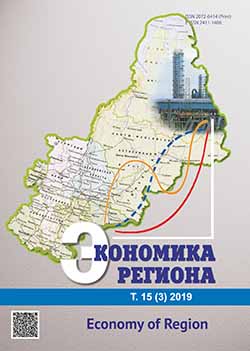МОДЕЛИ СЦЕНАРНОГО ПРОГНОЗИРОВАНИЯ РАЗВИТИЯ
СЕЛЬСКОГО ХОЗЯЙСТВА РЕГИОНА
Models of Scenario Forecasting of the Region’s Agriculture Development
Author(s): Denis Yuryevich Samygin, Nikolaj Georgievich Baryshnikov, Ljudmila Alekseevna MizjurkinaSubject(s): Economy
Published by: Институт экономики Уральского отделения Российской академии наук
Keywords: strategic planning; scenario forecasting; project management; agriculture; food independence; empirical models; partial equilibrium models; anticipation methodology; instruments of forecasting
Summary/Abstract: The problem of efficient forecasting for the agriculture is connected with the imperfect methodological and instrumental substantiation of its development parameters. Systematisation of the western models of partial equilibrium has proved that projecting the international experience of forecasts’ substantiating on the Russian agrarian economy reduces the forecasts’quality and distorts the predicted situation for the food market. That happens because such models are based on different criteria and objectives for the farmers’ development. We developed modern models for substantiating the parameters of agricultural development and scenario forecasts. The research objectives are connected with generalisation, systematisation and critical assessment of the instruments used for agricultural forecasting in Russian and foreign practice. We focused on shaping the substantially different instruments of scenario forecasting and model calculations. We applied the method of econometric diagnostics, the partial equilibrium model, and Cobb-Douglas production function. We used the data of financial reporting of 250 agricultural manufacturers from Penza oblast for the period from 2006 to 2016 as the study’s information basis. Further,we developed a set of scenario forecasting models, which are significantly different. These models have the functional capabilities of assessing the prospects of the agricultural development taking into account the attained production level, agrarian market’s environment, state measures, key factors of the agricultural products’ output. Based on the assessment of these models and diagnosed results, we concluded that the existing trends of forward movement in terms of the agricultural production’s supply are insufficient, as they do not fully satisfy the demand. We revealed the elasticity and disproportionality of the relationships between the growth rates of supply and demand in the agro-food market. Moreover, we collected the data on the qualitative dependence of the activities’ results in total on the factors of agricultural production and the state support measures. These factors show the threshold of expediency for additional investments of land, labour, capital and subsidies. This information will allow improving the economic mechanism of forecasting the agricultural strategic development. Additionally, it will contribute to strengthening the focus on the outcome of the manufacturers’ activities and increasing the level of achievement of the anticipated indicators
Journal: Экономика региона
- Issue Year: 15/2019
- Issue No: 3
- Page Range: 865-879
- Page Count: 14
- Language: Russian

